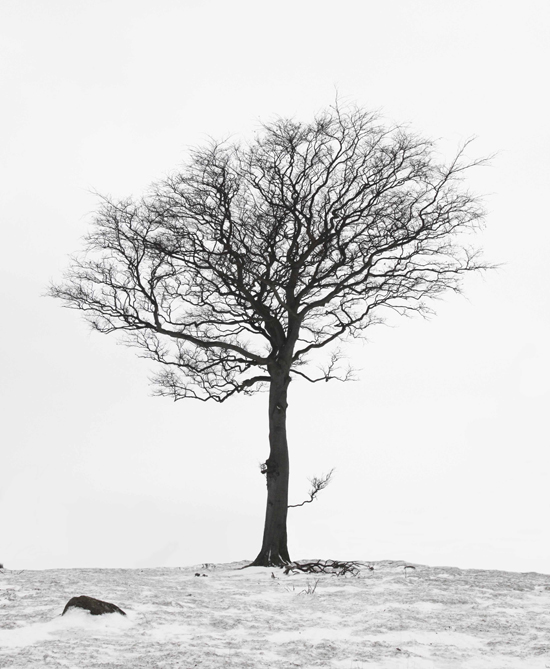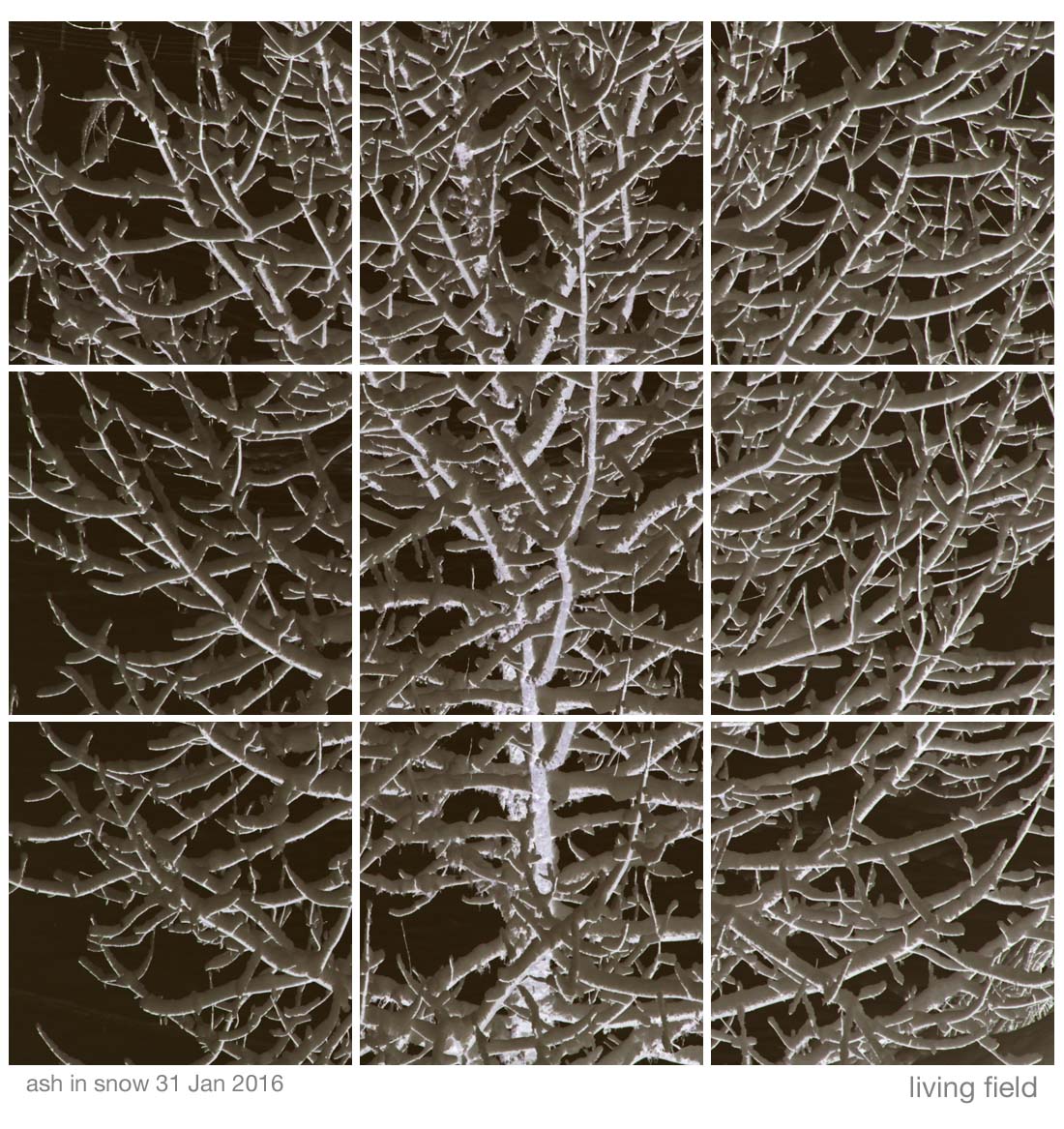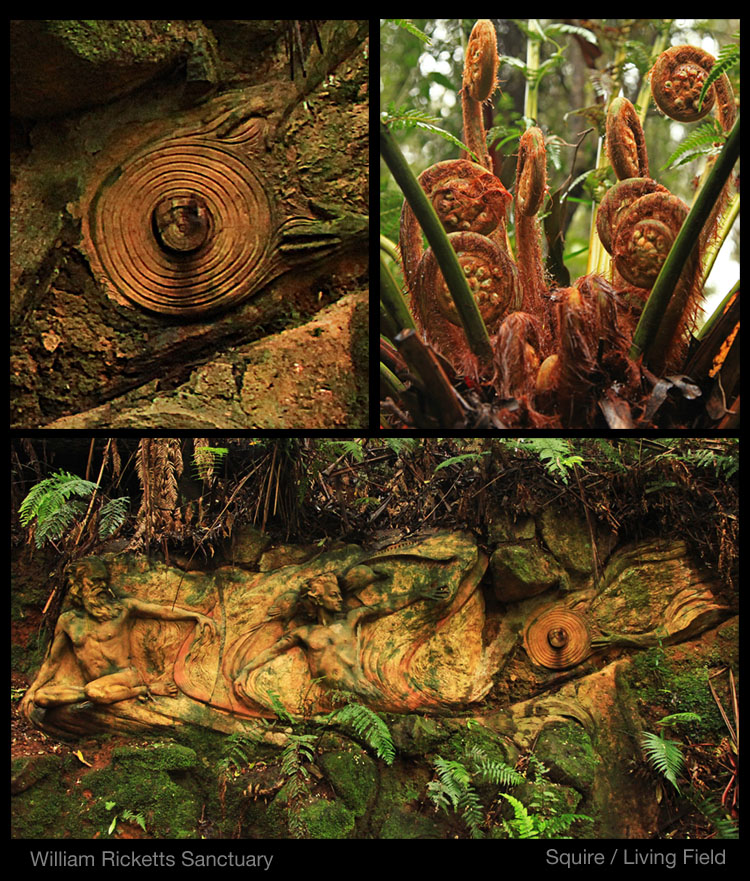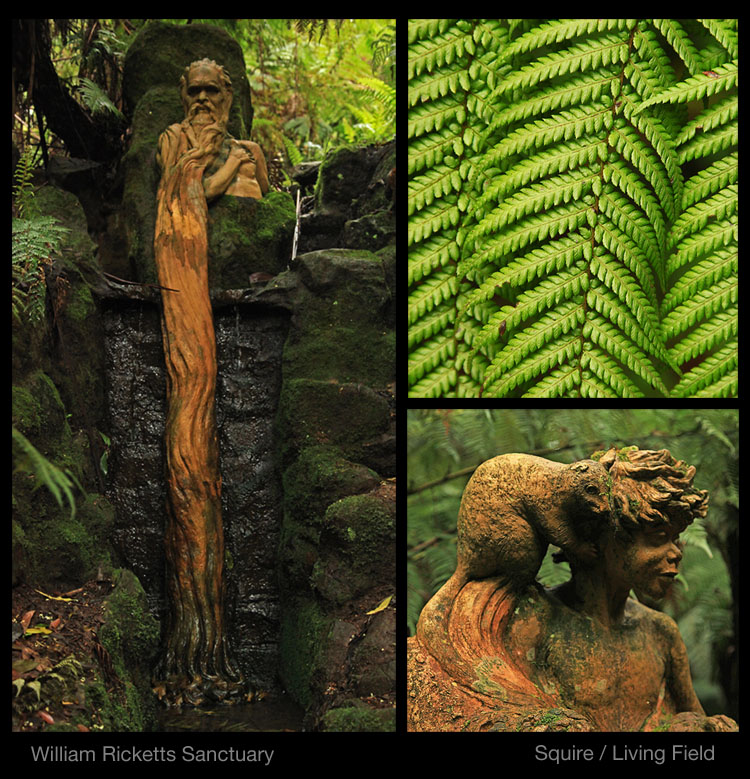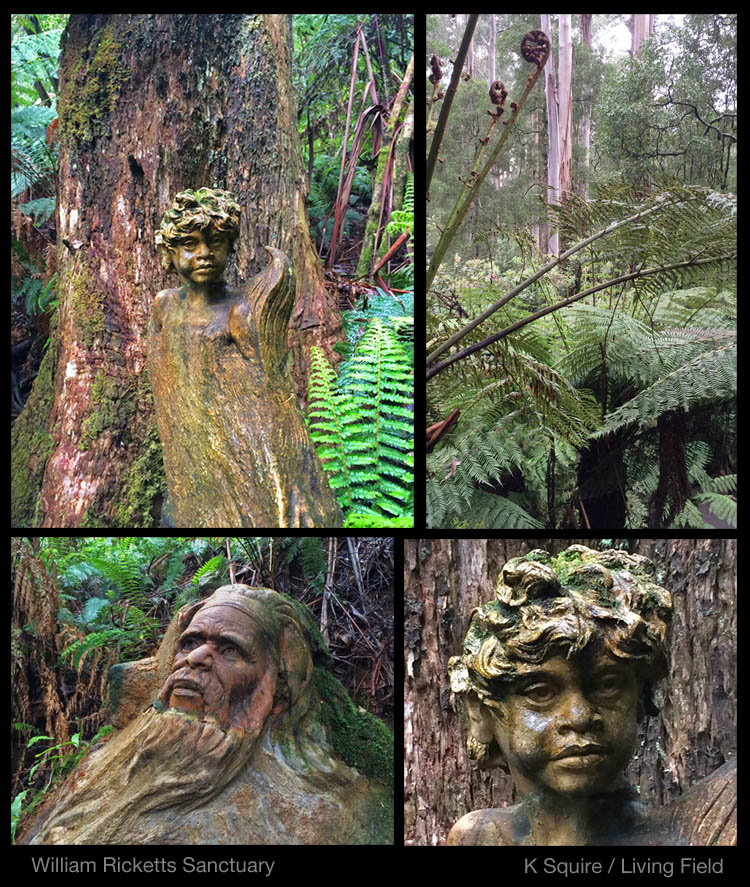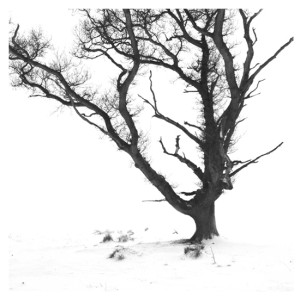Ash tree covered in snow (reverse) on the last day of January 2016
Tag: tree
Among tree ferns and mountain ash – the William Ricketts Sanctuary
William Ricketts began in 1934 to create his Sanctuary in a hilly region of the Dandenong Ranges in Victoria, Australia. He fused fired-clay images, mainly of Aboriginal people, with the lie of slope and rock on a hillside vegetated with trees and tree-ferns. He believed that people could live together and with nature, and that destruction and exploitation were not inevitable.
The images are now shaded by layers of vegetation. The upper canopy is mostly the leaf and branch of australian mountain ash, Eucalyptus regnans, tall and straight, said to be the tallest of the Angiosperms (non-conifers), and so very different from our own mountain ash or rowan. Below them are a few medium sized trees and then the tree ferns, luxuriant above the paths and sculptures. (A part of a tree fern is included in each of the sets of images on this page.)
At the base are herbs, ferns and mosses, growing close to and in some instances on the sculptures. This proximity gives the site an organic feel, the images becoming part of the scene, aided by the artist taking casts of the rocks so that he could match the base of the clay precisely with its intended location.
The clay images come alive in their setting. Many are part covered in a green algal film that must change with the seasons. Water droplets lie on them. Rivulets of water flow over them. Insects and fallen leaves rest on them and they change as the gums and tree ferns filter the light. There are touches of William Blake in the way figures swirl and flow into each other.
Ricketts was born in 1898, a little more than a century after the main phase of European colonisation began. He spent many years living with Aboriginal Australians, learning their approach to life and how they managed vegetation and land. He also created works for natural locations farther north, in central Australia.
He died in 1993, aged 94. He lives through the Sanctuary, his various other works and a few writings, but most of all through the memories of people who have seen his works in their intended setting.
The Sanctuary is managed by Parks Victoria. As with all other images on the Living Field site, images of William Ricketts’ works here are displayed ‘not for profit’ (taken October 2015).
Sources
Parks Victoria State Government web page on the William Ricketts Sanctuary (with access to a downloadable PDF guide)
Brady P. 1995. Whitefella Dreaming: the authorised biography of William Ricketts. Published by Preferred Image.
The Wikipedia entry gives further references.
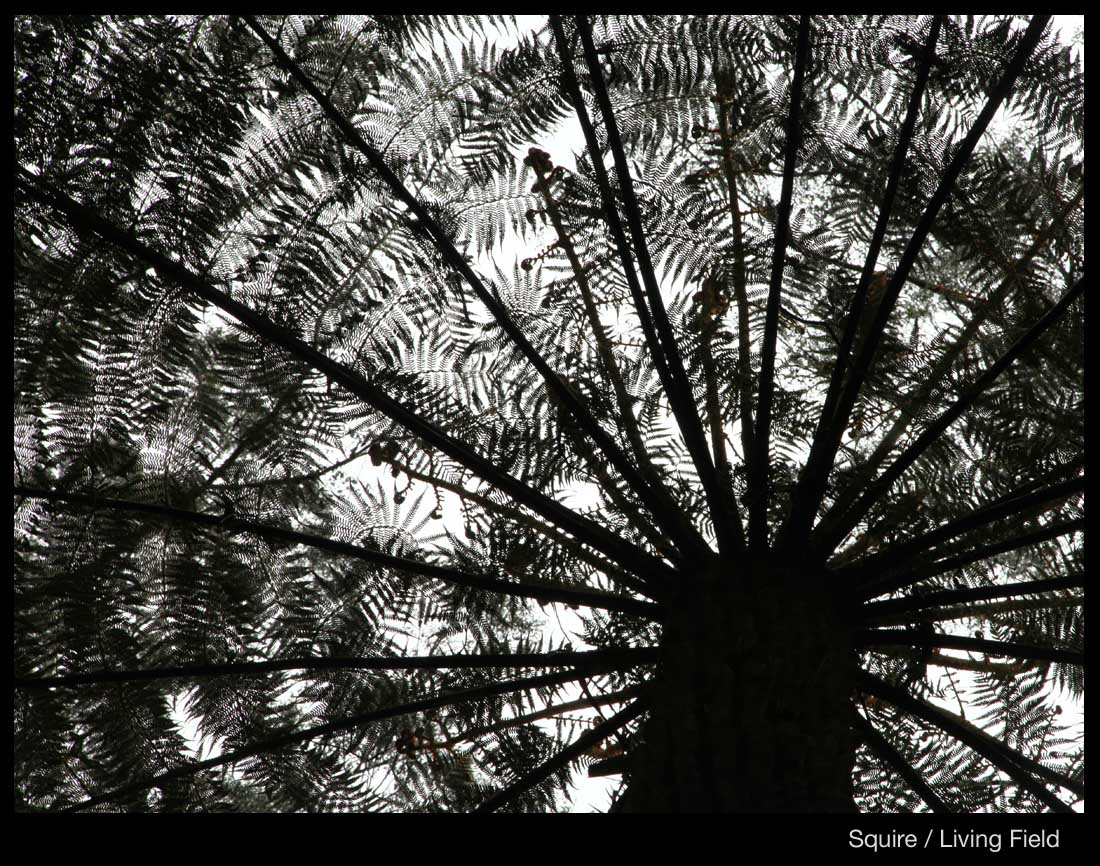
Thorn 2
The hawthorn Crataegus monogyna is the fourth of the common small trees of the Rose family to flower white in spring and early summer. It follows blackthorn, wild cherry (gean) and bird cherry, reaching its peak flowering in May, and unlike the blackthorn puts out its leaves before it flowers. While marsh marigold flowers before May Day and before the second cross quarter day of the year, hawthorn here reaches its peak flowering in the middle of the month. This year, 2014, all four of the thorns and cherries were covered in turn in masses of white – a spectacular sight.
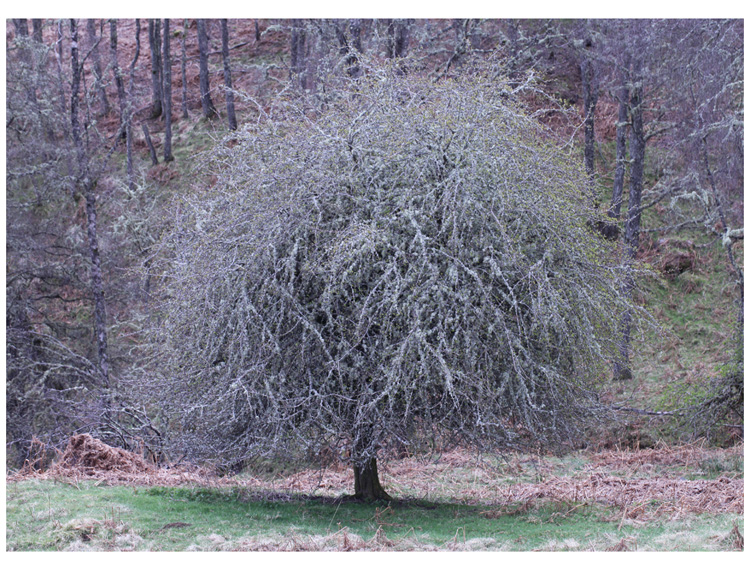
Hawthorn is the last in the year of the small trees with a clear white blossom and the last with a fragrance. Next comes rowan with a mousy tinge to its flowers, and the much rarer wild service tree, even more mousy in look, and in smell too – that first-whiff-of-dead-mouse unmistakably filtering down from the tree’s branches as it filters down from the deceased rodent in your roof space.
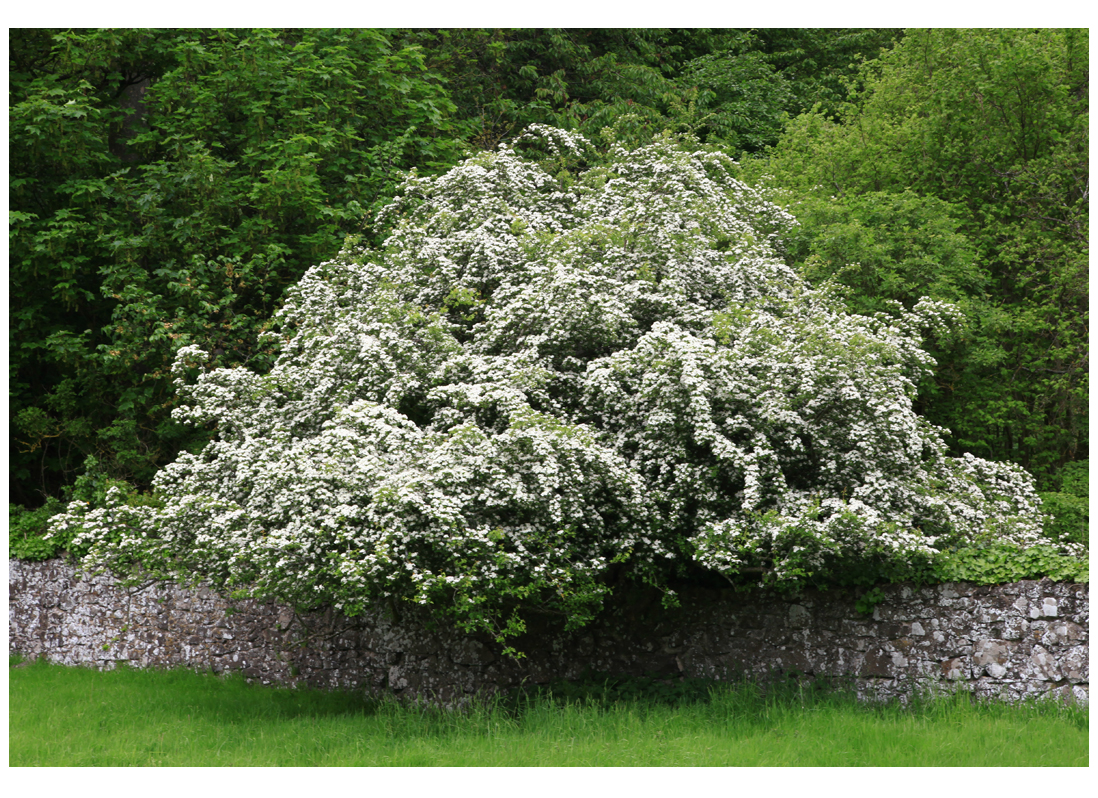
Hawthorn, if left in a clearing and unchopped, forms a fine small tree, as in the upper image above, just coming into leaf at Balnaguard Glen, and immediately above, in flower behind a stone wall at the southern base of the Sidlaw Hills. It is more common in a hedge, sometimes planted, sometimes self-sown. Where hedges are cut close each year, it hardly flowers, except in gaps or at the ‘ends’, for example next to a gate.
Hawthorn joins meadowsweet, agrimony, lady’s mantle, wood avens, raspberry, strawberry, cherries, apples and pears as useful members of the Rose family. It makes a good thorny hedge (to keep stock in and – historically ? – people out), a hard wood for tool handles, and a source material for dyes, teas and various concoctions. Its many mythical and supernatural associations are related in Grigson and Mabey’s Flora Britannica.
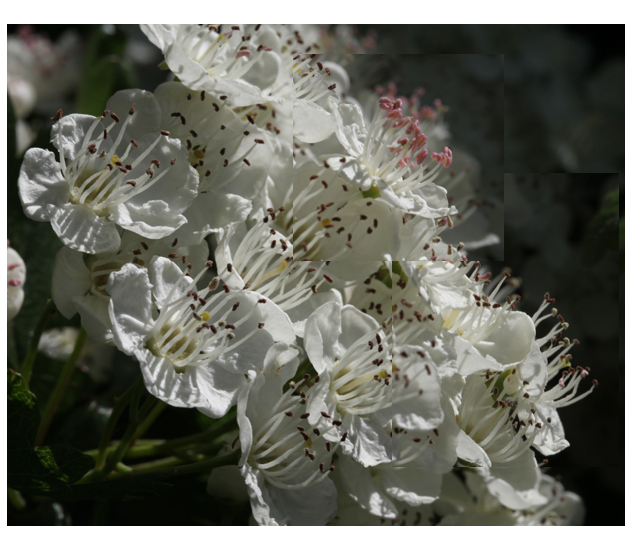
The flowers of the Rose family are simple, most parts distinct and visible. The sepals and petals are usually in fives, as in the image above, and the central female, tubular stigma is surrounded by many male stamens whose pollen-bearing anthers change from a first, fleshy, deep pink to brown and then shrivelled black, all in a few days. In the compound image above, of the same branch, but focussed on two different planes, the pink anthers are of a flower just opened while the rest are past their prime.
The fruits, known as haws, ripen to crimson in autumn and define the croplands’ hedges and copses as much as the hips of the wild roses and the sloes of blackthorn. Few people now collect and know what to do with these natural products.
{to be continued]
Cherry 1
The wild cherry, also known as gean, Prunus avium is the second of the croplands’ wild cherries to flower. Like many wild trees, grown from seed, individuals differ in their tendency to be vegetative or reproductive. Some trees hardly flower while others cover themselves in a spectacular mass of white in late April and early May.
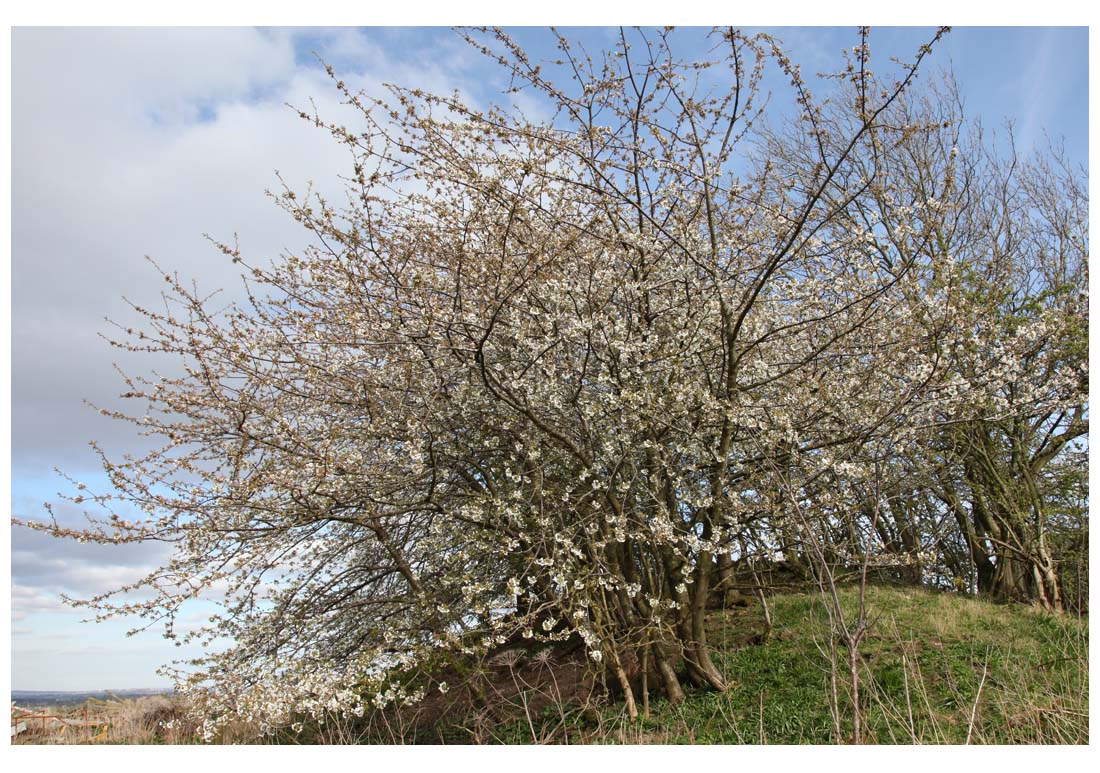
The gean can be cut into a hedge but more often appears as a small to medium tree, a strong trunk supporting a few main branches, off which emerge secondary branches almost at 90-degrees in some specimens. The best wild cherries are in tree lines or copses in unmanicured farmland. The one shown above, straggling a stony mound, was on the margin between arable and upland grazing. It looks as if the present tree might be supported by several ‘stems’ that grew around an old dead or cut trunk.

The cherries themselves are small and sour, a flavouring for alcoholic drinks, while the timber is strong, the gum is said to be ‘an old medicine … recommended for coughs’ (Grigson) and ‘the roots dye purple-red’ (Darwin T).
Unlike the blackthorn, the first to bloom, whose flowers are spattered all over the tangle of branches, the gean holds its flowers in clusters on straight branches, usually just trunk-wards of an expanding cluster of leaves. The sepals, that split and bend back to allow the white petals to unfurl, are reddish (see image above) whereas they are green in the blackthorn.
The wild cherry is increasingly common now as a result of plantings after road construction. Some of these trees look a bit too lush for a wild cherry.
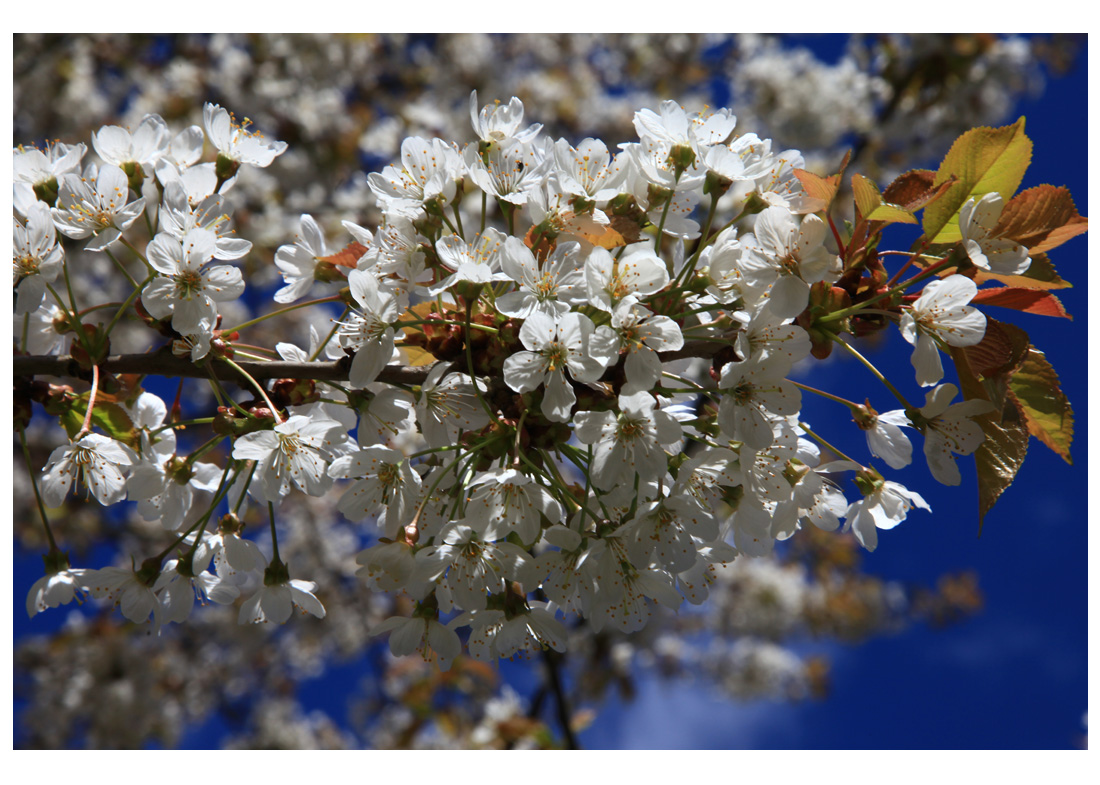
Thorn 1
The blackthorn Prunus spinosa is the first of the wild members of the genus Prunus, the cherries, to flower in the year. Its fruit – the black sloe – is not what we might expect of a cherry, being sour and unfit to eat, yet is used as a flavouring.
Generally the bush reaches full flower in mid-April while the leaves are still in bud, or just expanding, and where the plants are let to form thickets, they appear from a distance as if a heavy frost had covered the tangle of black branches.
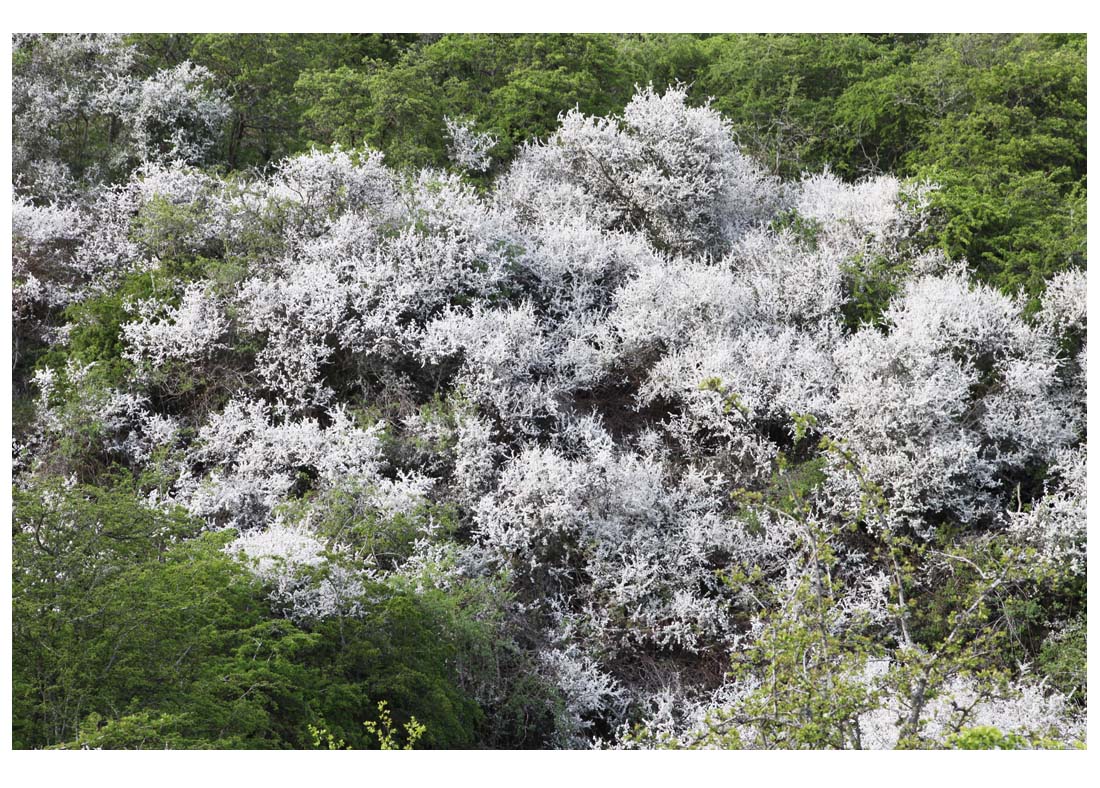
The spectacle of a blackthorn thicket in flower has become uncommon in the croplands – relegated to higher ground on the fringes of rough grazed pasture or in lowland hedges that have been serially uncut. Massed thorn is sometimes seen as plantings around roundabouts and slip roads but seldom impresses.
It is a fine plant of the hedgerow but rarely flowers on branches that are trimmed short.
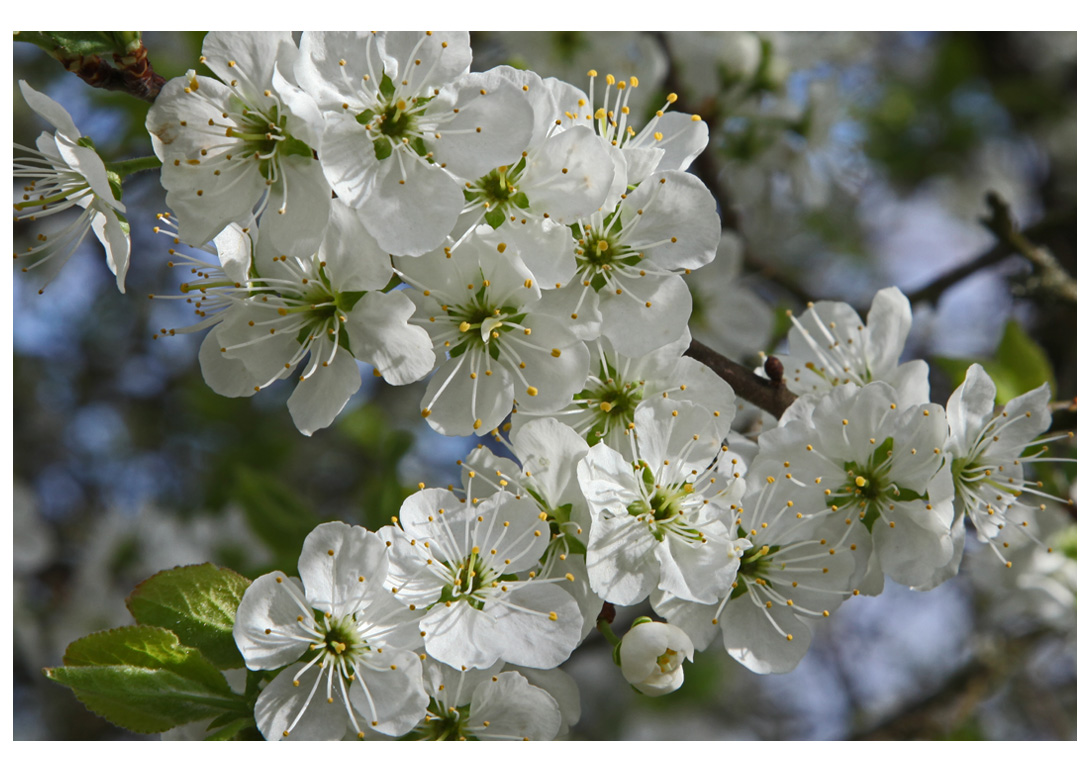
The flowers are simple and primitive, typical of the Rose family – five green sepals, which previously encased the flower bud, but now showing through the base of the five white petals, and many pollen-bearing (male) anthers ringing a central (female) style and stigma.
The flowers are held close to the woody stems, on stalks about 1 cm long, unlike the gean Prunus avium where the flowers hang in clumps on longer stalks and the bird cherry Prunus padus where they are held away from the stems on short floral branches.
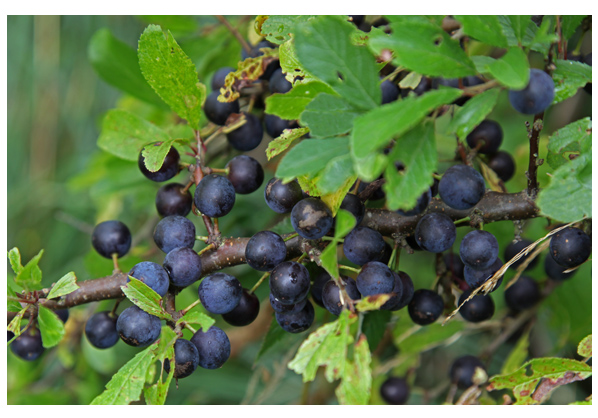
The blue-black fruit, like a small dark plum, is used in drinks, gin and sloe wine, and has a long history as a medicinal and dye. It turns dark blue from green in autumn, and if not removed, remains black and slowly withering throughout the winter when the leaves are gone.
Occasionally the blackthorn grows into a small tree, as the one by a lane in the images below.
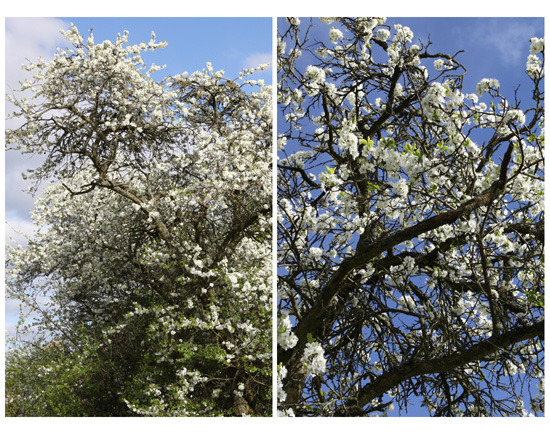
Wild cherry
Oak in white
Spring equinox
The croplands have not seen deep frost and snow this winter. They’ve basked in single-figure-Celsius warmth. By the spring equinox on 20 March 2014, the soil was not cold to the hand, and the winter cereals and oilseeds, sown last August to October, were almost covering the fields in a thin layer of green.
Sunrise is racing northwards now, as fast as it gets – and only three months to the summer solstice.
Back a year – to this day in 2013 – when large tracts of these islands were covered in deep snow and a deep cold that killed stock and set back crops. The northern cropland got off lightly, yet the higher land here was white on 23 March 2013.
This was the scene on Dron Hill in east Perthshire, a great beech Fagus sylvatica, looking to Dunsinane but etched on white. Dron was an iron age encampment or fort, a reminder that crops and stock were tended here 2500 years ago, and long before that.
